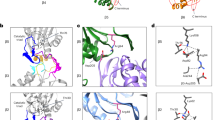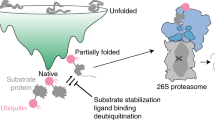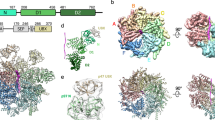Abstract
The proteasome is the main ATP-dependent protease in eukaryotic cells and controls the concentration of many regulatory proteins in the cytosol and nucleus. Proteins are targeted to the proteasome by the covalent attachment of polyubiquitin chains. The ubiquitin modification serves as the proteasome recognition element but by itself is not sufficient for efficient degradation of folded proteins. We report that proteolysis of tightly folded proteins is accelerated greatly when an unstructured region is attached to the substrate. The unstructured region serves as the initiation site for degradation and is hydrolyzed first, after which the rest of the protein is digested sequentially. These results identify the initiation site as a novel component of the targeting signal, which is required to engage the proteasome unfolding machinery efficiently. The proteasome degrades a substrate by first binding to its ubiquitin modification and then initiating unfolding at an unstructured region.
This is a preview of subscription content, access via your institution
Access options
Subscribe to this journal
Receive 12 print issues and online access
$189.00 per year
only $15.75 per issue
Buy this article
- Purchase on Springer Link
- Instant access to full article PDF
Prices may be subject to local taxes which are calculated during checkout






Similar content being viewed by others
References
Glickman, M.H. & Ciechanover, A. The ubiquitin-proteasome proteolytic pathway: destruction for the sake of construction. Physiol. Rev. 82, 373–428 (2002).
Baumeister, W., Walz, J., Zühl, F. & Seemüller, E. The proteasome: paradigm of a self-compartmentalizing protease. Cell 92, 367–380 (1998).
Groll, M. et al. Structure of 20S proteasome from yeast at 2.4 Å resolution. Nature 386, 463–471 (1997).
Groll, M. et al. A gated channel into the proteasome core particle. Nat. Struct. Biol. 7, 1062–1067 (2000).
Wenzel, T. & Baumeister, W. Conformational constraints in protein degradation by the 20S proteasome. Nat. Struct. Biol. 2, 199–204 (1995).
Johnston, J.A., Johnson, E.S., Waller, P.R.H. & Varshavsky, A. Methotrexate inhibits proteolysis of dihydrofolate reductase by the N-end rule pathway. J. Biol. Chem. 270, 8172–8178 (1995).
Deveraux, Q., Ustrell, V., Pickart, C. & Rechsteiner, M. A 26S protease subunit that binds ubiquitin conjugates. J. Biol. Chem. 269, 7059–7061 (1994).
Lam, Y.A., Lawson, T.G., Velayutham, M., Zweier, J.L. & Pickart, C.M. A proteasomal ATPase subunit recognizes the polyubiquitin degradation signal. Nature 416, 763–767 (2002).
Braun, B.C. et al. The base of the proteasome regulatory particle exhibits chaperone-like activity. Nat. Cell Biol. 1, 221–226 (1999).
Lee, C., Schwartz, M.P., Prakash, S., Iwakura, M. & Matouschek, A. ATP-dependent proteases degrade their substrates by processively unraveling them from the degradation signal. Mol. Cell 7, 627–637 (2001).
Kenniston, J.A., Baker, T.A., Fernandez, J.M. & Sauer, R.T. Linkage between ATP consumption and mechanical unfolding during the protein processing reactions of an AAA+ degradation machine. Cell 114, 511–520 (2003).
Breitschopf, K., Bengal, E., Ziv, T., Admon, A. & Ciechanover, A. A novel site for ubiquitination: the N-terminal residue, and not internal lysines of MyoD, is essential for conjugation and degradation of the protein. EMBO J. 17, 5964–5973 (1998).
Pickart, C.M. Mechanisms underlying ubiquitination. Annu. Rev. Biochem. 70, 503–533 (2001).
Thrower, J.S., Hoffman, L., Rechsteiner, M. & Pickart, C.M. Recognition of the polyubiquitin proteolytic signal. EMBO J. 19, 94–102 (2000).
Verma, R. et al. Role of Rpn11 metalloprotease in deubiquitination and degradation by the 26S proteasome. Science 298, 611–615 (2002).
Petroski, M.D. & Deshaies, R.J. Context of multiubiquitin chain attachment influences the rate of Sic1 degradation. Mol. Cell 11, 1435–1444 (2003).
Hoskins, J.R., Yanagihara, K., Mizuuchi, K. & Wickner, S. ClpAP and ClpXP degrade proteins with tags located in the interior of the primary sequence. Proc. Natl. Acad. Sci. USA 99, 11037–11042 (2002).
Kihara, A., Akiyama, Y. & Ito, K. Dislocation of membrane proteins in FtsH-mediated proteolysis. EMBO J. 18, 2970–2981 (1999).
Reid, B.G., Fenton, W.A., Horwich, A.L. & Weber-Ban, E.U. ClpA mediates directional translocation of the substrate proteins into the ClpP protease. Proc. Natl. Acad. Sci. USA 98, 3768–3772 (2001).
Herman, C., Prakash, S., Lu, C.Z., Matouschek, A. & Gross, C.A. Lack of a robust unfoldase activity confers a unique level of substrate specificity to the universal AAA protease FtsH. Mol. Cell 11, 659–669 (2003).
Bachmair, A., Finley, D. & Varshavsky, A. In vivo half-life of a protein is a function of its amino-terminal residue. Science 234, 179–186 (1986).
Orian, A. et al. Structural motifs involved in ubiquitin-mediated processing of the NF-κB precursor p105: roles of the glycine-rich region and a downstream ubiquitination domain. Mol. Cell Biol. 19, 3664–3673 (1999).
Orlowski, M. & Wilk, S. Ubiquitin-independent proteolytic functions of the proteasome. Arch. Biochem. Biophys. 415, 1–5 (2003).
Flynn, J.M., Neher, S.B., Kim, Y.I., Sauer, R.T. & Baker, T.A. Proteomic discovery of cellular substrates of the ClpXP protease reveals five classes of ClpX-recognition signals. Mol. Cell 11, 671–683 (2003).
Uversky, V.N. What does it mean to be natively unfolded? Eur. J. Biochem. 269, 2–12 (2002).
Viitanen, P.V., Donaldson, G.K., Lorimer, G.H., Lubben, T.H. & Gatenby, A.A. Complex interactions between the chaperonin 60 molecular chaperone and dihydrofolate reductase. Biochemistry 30, 9716–9723 (1991).
Bachmair, A. & Varshavsky, A. The degradation signal in a short-lived protein. Cell 56, 1019–1032 (1989).
Stack, J.H., Whitney, M., Rodems, S.M. & Pollok, B.A. A ubiquitin-based tagging system for controlled modulation of protein stability. Nat. Biotechnol. 18, 1298–1302 (2000).
Liu, C.W., Corboy, M.J., DeMartino, G.N. & Thomas, P.J. Endoproteolytic activity of the proteasome. Science 299, 408–411 (2003).
Peng, J. et al. A proteomics approach to understanding protein ubiquitination. Nat. Biotechnol. 21, 921–926 (2003).
Scherer, D.C., Brockman, J.A., Chen, Z., Maniatis, T. & Ballard, D.W. Signal-induced degradation of IkBa requires site-specific ubiquitination. Proc. Natl. Acad. Sci. USA 92, 11259–11263 (1995).
Glotzer, M., Murray, A.W. & Kirschner, M.W. Cyclin is degraded by the ubiquitin pathway. Nature 349, 132–138 (1991).
Rodriguez, M.S., Desterro, J.M., Lain, S., Lane, D.P. & Hay, R.T. Multiple C-terminal lysine residues target p53 for ubiquitin-proteasome–mediated degradation. Mol. Cell Biol. 20, 8458–8467 (2000).
Hoppe, T. et al. Activation of a membrane-bound transcription factor by regulated ubiquitin/proteasome-dependent processing. Cell 102, 577–586 (2000).
Delagoutte, E. & von Hippel, P.H. Helicase mechanisms and the coupling of helicases within macromolecular machines. Part I: Structures and properties of isolated helicases. Q. Rev. Biophys. 35, 431–478 (2002).
Tsu, C.A., Kossen, K. & Uhlenbeck, O.C. The Escherichia coli DEAD protein DbpA recognizes a small RNA hairpin in 23S rRNA. RNA 7, 702–709 (2001).
Levchenko, I., Seidel, M., Sauer, R.T. & Baker, T.A. A specificity-enhancing factor for the ClpXP degradation machine. Science 289, 2354–2356 (2000).
Neher, S.B., Sauer, R.T. & Baker, T.A. Distinct peptide signals in the UmuD and UmuD′ subunits of UmuD/D′ mediate tethering and substrate processing by the ClpXP protease. Proc. Natl. Acad. Sci. USA 100, 13219–13224 (2003).
Elsasser, S. et al. Proteasome subunit Rpn1 binds ubiquitin-like protein domains. Nat. Cell Biol. 4, 725–730 (2002).
Alberti, S. et al. Ubiquitylation of BAG-1 suggests a novel regulatory mechanism during the sorting of chaperone substrates to the proteasome. J. Biol. Chem. 277, 45920–45927 (2002).
Rao, H. & Sastry, A. Recognition of specific ubiquitin conjugates is important for the proteolytic functions of the ubiquitin-associated domain proteins Dsk2 and Rad23. J. Biol. Chem. 277, 11691–11695 (2002).
Raasi, S. & Pickart, C.M. Rad23 ubiquitin-associated domains (UBA) inhibit 26S proteasome-catalyzed proteolysis by sequestering lysine 48–linked polyubiquitin chains. J. Biol. Chem. 278, 8951–8959 (2003).
Kleijnen, M.F., Alarcon, R.M. & Howley, P.M. The ubiquitin-associated domain of hPLIC-2 interacts with the proteasome. Mol. Biol. Cell 14, 3868–3875 (2003).
Bateman, A. et al. The Pfam protein families database. Nucleic Acids Res. 32 (Database issue), D138–D141 (2004).
Dai, R.M., Chen, E., Longo, D.L., Gorbea, C.M. & Li, C.C. Involvement of valosin-containing protein, an ATPase co-purified with IκBα and 26 S proteasome, in ubiquitin-proteasome–mediated degradation of IκBα. J. Biol. Chem. 273, 3562–3573 (1998).
Lam, Y.A., Xu, W., DeMartino, G.N. & Cohen, R.E. Editing of ubiquitin conjugates by an isopeptidase in the 26S proteasome. Nature 385, 737–740 (1997).
Leggett, D.S. et al. Multiple associated proteins regulate proteasome structure and function. Mol. Cell 10, 495–507 (2002).
Hartley, R.W. A two state conformational transition of the extracellular ribonuclease of Bacillus amyloliquefaciens (barnase) induced by sodium dodecyl sulfate. Biochemistry 14, 2367–2370 (1975).
Rood, J.I., Laird, A.J. & Williams, J.W. Cloning of the Escherichia coli K-12 dihydrofolate reductase gene following mu-mediated transposition. Gene 8, 255–265 (1980).
Iwakura, M., Nakamura, T., Yamane, C. & Maki, K. Systematic circular permutation of an entire protein reveals essential folding elements. Nat. Struct. Biol. 7, 580–585 (2000).
Varshavsky, A. The N-end rule. Cell 69, 725–735 (1992).
Matouschek, A. et al. Active unfolding of precursor proteins during mitochondrial protein import. EMBO J. 16, 6727–6736 (1997).
Gonda, D.K. et al. Universality and structure of the N-end rule. J. Biol. Chem. 264, 16700–16712 (1989).
Larsen, C.N. & Finley, D. Protein translocation channels in the proteasome and other proteases. Cell 91, 431–434 (1997).
Acknowledgements
We thank C. Pickart, L. Hicke, J. Widom, C. Holmberg and O. Uhlenbeck for advice and helpful comments on the manuscript. We also thank P. Bellare, J. Schnell, N. Jaffe and A. Wilcox for carefully reading and correcting the manuscript. M. Fisher (University of Kansas Medical Center) provided purified GroEL and advice. We acknowledge the use of the instruments at the Keck Biophysics Facility of the Robert H. Lurie Comprehensive Cancer Center at Northwestern University. The work was supported by US National Institutes of Health grant R01GM63004, by a Scholar Award to A.M. from the Leukemia and Lymphoma Society and by a Gramm Travel Fellowship Award to S.P. from the Robert H. Lurie Comprehensive Cancer Center at Northwestern University.
Author information
Authors and Affiliations
Corresponding author
Ethics declarations
Competing interests
The authors declare no competing financial interests.
Rights and permissions
About this article
Cite this article
Prakash, S., Tian, L., Ratliff, K. et al. An unstructured initiation site is required for efficient proteasome-mediated degradation. Nat Struct Mol Biol 11, 830–837 (2004). https://doi.org/10.1038/nsmb814
Received:
Accepted:
Published:
Issue Date:
DOI: https://doi.org/10.1038/nsmb814
This article is cited by
-
N-terminal acetylation can stabilize proteins independent of their ubiquitination
Scientific Reports (2023)
-
Intracellular arginine-dependent translation sensor reveals the dynamics of arginine starvation response and resistance in ASS1-negative cells
Cancer & Metabolism (2021)
-
Abelson kinase’s intrinsically disordered region plays essential roles in protein function and protein stability
Cell Communication and Signaling (2021)
-
Aboard the ISS: intersubunit signaling revealed in the p97 ATPase
Nature Structural & Molecular Biology (2021)
-
Targeted substrate loop insertion by VCP/p97 during PP1 complex disassembly
Nature Structural & Molecular Biology (2021)



